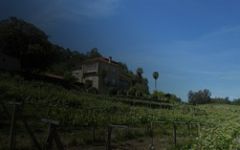Lusco Zios Albarino 2014


Product Details
Your Rating
Somm Note
Winemaker Notes
Enjoy in its youth with fresh, delicately-prepared seafood.


A subsidiary of Grupo de Tares, this winery specializes in the production of Albarifio. Lusco is local dialect for “twilight,” as evidenced by their logo. Pazos de Lusco successfully combines history and modernity to craft limited quantities of elegant, flavorful, age-worthy white wines using the appellation’s indigenous varietal and native yeasts that accurately reflect the terroir.
Pazos de Lusco sources their fruit from both estate-owned vineyards and those under long-term lease that are under the management of the winery’s viticultural team. All are planted exclusively to Albarino using the traditional pergola training method.The historical Pazo Pineiro estate surrounding the winery consists of 6 hectares of vineyards, protected by dense forest on three sides and stretching down the mountainside to the banks of the Mino River.
This mountainous area’s climatic conditions greatly vary, ranging from very hot and dry to cold and damp. Soils vary as well, but are generally deep and fairly acidic. Large amounts of decomposed granite provide excellent drainage, a vital benefit for this area of excessive rainfall. Pazos de Lusco practices sustainable farming methods in an effort to respect their land. In doing so, they are able to capture the integrity of the terroir in their wines.

Bright and aromatic with distinctive floral and fruity characteristics, Albariño has enjoyed a surge in popularity and an increase in plantings over the last couple of decades. Thick skins allow it to withstand the humid conditions of its homeland, Rías Baixas, Spain, free of malady, and produce a weighty but fresh white. Somm Secret—Albariño claims dual citizenship in Spain and Portugal. Under the name Alvarinho, it thrives in Portugal’s northwestern Vinho Verde region, which predictably, borders part of Spain’s Rías Baixas.

Named after the rías, or estuarine inlets, that flow as far as 20 miles inland, Rías Baixas is an Atlantic coastal region with a cool and wet maritime climate. The entire region claims soil based on granite bedrock, but the inlets create five subregions of slightly different growing environments for its prized white grape, Albariño.
Val do Salnés on the west coast is said to be the birthplace of Albariño; it is the coolest and wettest of all of the regions. Having been named as the original subregion, today it has the most area under vine and largest number of wineries.
Ribeira do Ulla in the north and inland along the Ulla River is the newest to be included. It is actually the birthplace of the Padrón pepper!
Soutomaior is the smallest region and is tucked up in the hills at the end of the inlet called Ria de Vigo. Its soils are light and sandy over granite.
O Rosal and Condado do Tea are the farthest south in Rías Baixas and their vineyards actually cover the northern slopes of the Miño River, facing the Vinho Verde region in Portugal on its southern bank.
Albariño gives this region its fame and covers 90% of the area under vine. Caiño blanco, Treixadura and Loureira as well as occasionally Torrontés and Godello are permitted in small amounts in blends with Albariño. Red grapes are not very popular but Mencía, Espadeiro and Caiño Tinto are permitted and grown.
